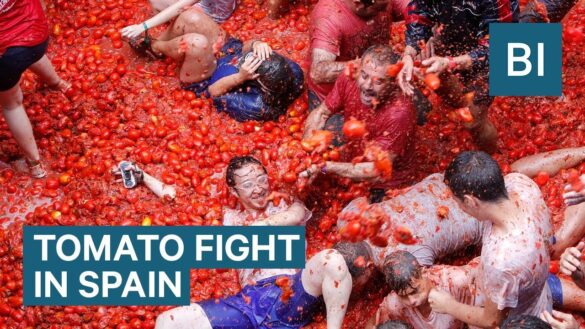La Tomatina, the world-famous food festival in Buñol, Spain, is a spectacular celebration of joy, chaos, and camaraderie. It takes place annually on the last Wednesday of August, drawing thousands of people from all corners of the globe. What makes this event so extraordinary is its unique nature—a massive, colorful, and utterly playful tomato fight. The entire town of Buñol, a small municipality in the province of Valencia, is transformed into a sea of red as participants hurl ripe tomatoes at each other in a spirited frenzy. This one-hour-long battle of tomatoes is not just a chaotic event, but a highly organized celebration that reflects the vibrant cultural life of Spain and its joyous way of embracing the end of summer.
La Tomatina is more than just a food fight; it is a symbol of community, festivity, and tradition. The history, organization, and experience of La Tomatina offer a window into Spain’s lively festival culture, a culture that combines spontaneity with deep-rooted customs. Whether it’s the preparations leading up to the event, the festive atmosphere that engulfs the town, or the incredible energy of the main event itself, La Tomatina is an unforgettable spectacle that captures the hearts of all who witness it and experience it firsthand.
The History Behind La Tomatina
The origins of La Tomatina are shrouded in mystery, with several theories surrounding how this peculiar tradition began. One of the most widely accepted stories dates back to 1945. During a parade in Buñol, a group of young people sought to join in the procession with musicians and giants, but they accidentally caused one of the participants to fall. In retaliation, a nearby vegetable stand was raided, and tomatoes were used as the ammunition for a friendly altercation. This impromptu food fight gained momentum and became an annual tradition, despite initial opposition from local authorities. The festival was banned several times in the 1950s, but passionate locals and participants protested, and La Tomatina was reinstated permanently in 1957.
Over the decades, La Tomatina has evolved from a local quarrel into an internationally celebrated event, drawing tourists and thrill-seekers from all over the world. The event is now officially supported by the town council, and its fame has grown so much that people now need tickets to participate. Though the original spontaneous nature has given way to a more structured event, the spirit of La Tomatina remains the same: a joyful, messy, and lively celebration of fun.
Preparing for the Big Day: The Town of Buñol Transforms
In the days leading up to La Tomatina, the town of Buñol undergoes an incredible transformation. Although Buñol is a relatively quiet town for most of the year, its population of around 9,000 swells to nearly 50,000 as visitors arrive to take part in the festival. Streets are lined with temporary stands selling food, drinks, and festival memorabilia, while local businesses and residents take steps to protect their buildings from the onslaught of tomatoes. Storefronts are covered in plastic sheets, windows are boarded up, and even some streets are blocked off to create a safe and enclosed space for the event.
Locals embrace the influx of visitors with open arms, preparing to celebrate alongside them. The day before the festival, the town is already buzzing with excitement. Music fills the air, and the atmosphere becomes one of anticipation and festivity. Many participants wear old clothes or white outfits, knowing that by the end of the tomato fight, they will be drenched in tomato juice. Some people even wear goggles to protect their eyes from the acidic juice of the tomatoes, while others tie bandanas around their heads in a bid to minimize the mess. The energy builds as everyone gears up for the impending madness.
While La Tomatina itself lasts only an hour, the preparations for the event take weeks. More than 145,000 kilograms of ripe tomatoes, sourced from the region of Extremadura, are specially brought in for the occasion. These tomatoes are chosen because they are overripe and not suitable for consumption, making them perfect for the fight. The streets are cleaned meticulously before and after the event, with fire trucks and street cleaners working swiftly to restore the town to normalcy once the fun has ended.
The Day of La Tomatina: A Frenzy of Red
On the morning of the big day, the town of Buñol comes alive. The festival begins at 10 a.m. with a unique ritual known as the Palo Jabón, where a greased pole is set up in the Plaza del Pueblo, the town’s central square. A ham is placed on top of the pole, and participants try to climb it to retrieve the prize. This can take a long time, and although it is not always successful, the crowd enjoys the spectacle, cheering on the brave climbers. Once the ham is claimed—or when enough attempts have been made—the signal is given for the tomato fight to begin.
At 11 a.m., a loud cannon is fired, marking the start of La Tomatina. Trucks filled with tons of ripe tomatoes roll into the main square, and the madness begins. Participants scramble to grab as many tomatoes as they can, squashing and throwing them at everyone around them. For the next hour, the streets of Buñol are transformed into a scene of chaos, with people covered head to toe in tomato pulp. There are few rules to this food fight, but one of the key guidelines is that participants must squash the tomatoes before throwing them, ensuring that no one gets hurt by a hard, unripe fruit.
The scene is surreal—red juice splashes everywhere, and the air is thick with the smell of tomatoes. Laughter fills the streets as participants joyfully engage in the frenzy. Despite the seeming disorder, there’s a sense of playfulness and camaraderie in the air. Strangers laugh together as they pelt each other with tomatoes, and for one hour, everyone is united in the pure, unbridled joy of the fight.
At precisely 12 p.m., the cannon sounds again, signaling the end of the fight. The streets, now ankle-deep in tomato pulp, begin to clear as participants make their way to nearby rivers, fountains, and public showers to clean off the red mess. Locals often assist by hosing down participants, and the atmosphere becomes one of relief and satisfaction after the intense, yet exhilarating experience.
The Aftermath and Celebration
After the tomato fight ends, the cleanup operation begins almost immediately. Despite the sheer volume of tomatoes used during La Tomatina, the town of Buñol is remarkably efficient in returning the streets to their usual condition. Fire trucks and cleaning crews wash away the tomato pulp, and within a few hours, the streets are back to normal. Interestingly, the acidity in the tomatoes acts as a natural cleaning agent, leaving the town’s streets cleaner than they were before the event.
Once participants have washed off the remnants of the fight, many head to local bars, restaurants, and open-air parties to continue celebrating. La Tomatina is not just about the tomato fight; it’s a day of revelry, where music, dancing, and good food take center stage. The town’s square becomes a hub of post-fight activity, with people sharing their experiences, laughing about the chaos, and enjoying traditional Spanish dishes like paella, tapas, and tortilla española. For many, the celebration continues late into the night, with the joyful energy of La Tomatina carrying through to the evening.
Experiencing La Tomatina: A Global Phenomenon
Although La Tomatina originated as a local festival, it has grown into a global phenomenon. Every year, people from countries as far away as Japan, Australia, and the United States make the pilgrimage to Buñol to participate in this unique event. The popularity of La Tomatina has even inspired similar events in other parts of the world, such as in Colombia and the United States, but none can match the authenticity and spirit of the original festival in Spain.
For many, the experience of La Tomatina is a bucket-list item. It offers a chance to be part of something larger than oneself, to embrace the chaos, and to create unforgettable memories. The thrill of throwing tomatoes in the heart of a crowd, the sense of being swept up in a wave of red, and the sheer fun of it all make La Tomatina one of the most iconic and beloved festivals in the world.
Conclusion: The Magic of La Tomatina
La Tomatina in Buñol, Spain, is far more than just a food fight—it’s a celebration of life, fun, and human connection. It reflects the festive spirit of Spain and the joy that can be found in even the most unexpected places, like a town square filled with tomatoes. Whether you’re a seasoned traveler, a festival enthusiast, or simply someone looking for a once-in-a-lifetime experience, La Tomatina offers an unforgettable adventure. The festival’s combination of history, tradition, spontaneity, and communal joy creates an event like no other, where thousands come together to embrace the messy, thrilling, and utterly delightful spectacle of the world’s largest tomato fight.
Learn More


